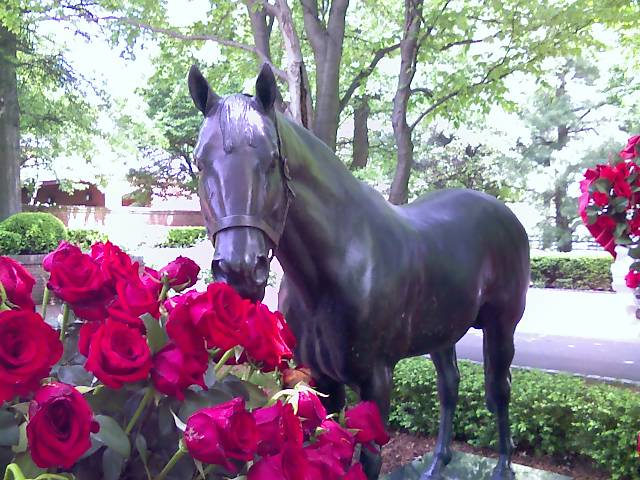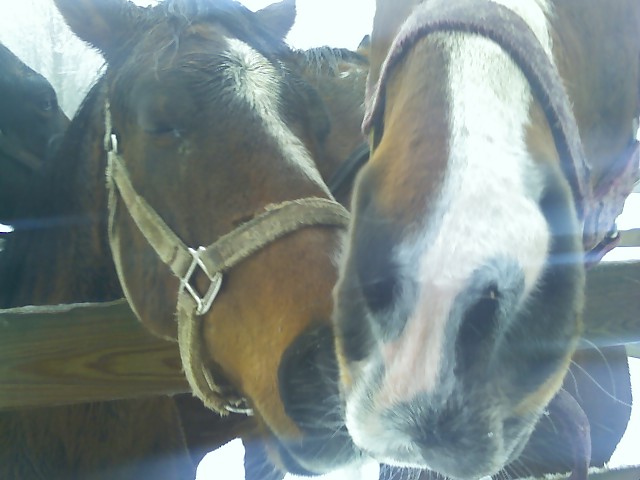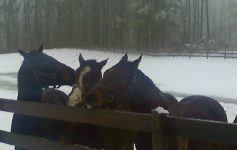
Introduction
Racing is the oldest sport in America, and surely, the most beautiful. Those of us who love the sport are fans for life. We hope to pique your interest, so you can join us in this exhilarating endeavour and become part of our community of fans and professionals.
Hence, Racing 101. This course is designed to help those of you who may be fascinated by the sport of horse racing, but have not-yet experienced the thrill and majesty of it all. Or you’ve gone to a racetrack, and immediately felt lost and confused. We want to help you overcome those feelings! Week-by-week, we’ll explore terms, strategies and factoids that will help you feel like a pro in no time. You may already be an experienced fan–this course is still for you! Your comments can help our “students” learn: Please feel free to write in and become involved. As we all learn more about the sport and bring others into the fold, the sport will grow.
Follow the lead of our magnificent Thoroughbreds, and remember to Run Fast, Turn Left–and never, ever give up.
Lesson 1: What is a Thoroughbred?
When people refer to “horse racing,” the first image that comes to mind is that of large, swift horses with a small person on back, screaming toward a finish line. More likely than not, those speedy horses toting a tiny person are Thoroughbreds–although racing Arabian horses is an older sport, and America is finally catching up with Arabian racing.
(Harness racing is another great sport, which we will explore in this blog, also. Stay tuned! The breed of horses that run on an oval, attached to a sulky [small cart], with a much larger human holding the reins, are Standardbreds.)
The Thoroughbred is a created breed of horse. That is, Thoroughbreds were intentionally created by human minds and hands in the 17th and early 18th Centuries, and have never lived in the wild.
So, if Thoroughbreds are members of an invented breed, where did they originate? And why were they created, in the first place? With all the thousands of horse breeds on Earth, why bother to invent yet-another breed?
The need for the breed…was speed. First, the definition:
When asked the question, “What is a Thoroughbred?” many people will respond that a Thoroughbred is something that is “…thoroughly bred,” a pure something-or-other. Auto makers often liken their vehicles to the concept. Note the recent ads on TV for GM: the collage of video footage features Thoroughbreds charging toward the camera. The association of the GM brand with the speed, strength and beauty of Thoroughbreds is intentional.
The word is usually confused with “purebred,” as in a “purebred German Shepherd Dog.”
Even Merriam-Webster’s online dictionary uses the word to describe something that is a purebred.
But a Thoroughbed, with a capital T, is the name of a specific breed of horse. When describing the breed, the word is always capitalized. While “Thoroughbred” often is used to incorrectly describe something of pure blood–the reverse use is inappropriate. “Purebred” is not the name of a breed of horse.
The Thoroughbred came into being because it occurred to three Englishmen that breeding sturdy, native British and Irish mares with Arabian stallions would produce a horse that was both hearty and fast. Three stallions, named for the gentlemen who imported and bred them, were therefore called the Darley Arabian; the Godolphin Arabian and the Byerly Turk. These three foundation sires hailed from the exotic, then-unfamiliar, region of our world that is the Middle East.
These three stallions are called the foundation sires, as every Thoroughbred on the Earth is descended from at least one of these horses, on both their distaff (Mother’s) and sire (Father’s) sides. Read that again: every Thoroughbred on the planet, in order to prove that they are, indeed, 100% Thoroughbred, must prove that they are descendants of at least one of the three foundation sires, on both sides.
For this reason, knowledge of a horse’s pedigree is essential in the world of Thoroughbred racing.
Darley, Godolphin and Byerly took their beautiful Arabian males and, perhaps unwittingly, literally laid the foundation for the animal that would become the second-fastest animal on Earth. The Thoroughbred is second only to the Cheetah, and–given the physics of weight and speed–there’s ample evidence to support the argument that the Thoroughbred is actually the fastest animal. (Cheetahs can go 60 mph, but weigh in at only 60 pounds. A Thoroughbred averages well above 40 mph in a race, and weighs an average of 1100 pounds. The math of weight vs. speed times strongly indicates that the Thoroughbred horse is actually capable of running faster than the Cheetah, were both animals the same size.)
The height of all horse breeds is measured in hands. A hand is considered to be four inches, that is, the width of a man’s hand. A Thoroughbred usually stands between 15 and 16 hands high–that is, the horse is measured up to its withers, the shoulder point at which the neck meets the horse’s body. So a Thoroughbred that is 16 hands high stands approximately 64″ high at the shoulder.
Thoroughbreds have the longest necks, proportionate to their bodies, of any breed. These graceful, long necks help the horse move forward. The next time you watch a horserace, notice the horses’ necks moving forward, rhythmically, as they run. This isn’t coincidental: this is divine design. The long necks, moving in rhythm with the legs, propel the horse forward.

Thoroughbreds’ noses are perfectly straight, or flat. (Except when they’re zeroing in on you for a kiss, like our friends above.)
(Their Arabian cousins, by contrast, have concave or “dished” noses.) Their eyes are set squarely on the sides of their heads, allowing for almost 360 degrees of vision. They have monocular vision–meaning that they see two separate things, one with each eye. This would confuse humans, for we have binocular vision: our brains tell us to meld the two things into one view. This is because our eyes are in the front of our heads.
But Thoroughbreds’ eyes allow them to see the horses on either side as they run–were they wild horses, they could also see predators approaching from either side, which would, of course, save their lives.
Their ears are long, but not as long as that of other breeds. Nostrils are set far-down on the face, near the full, velvety-soft lips.
Conformation is another very important consideration in the Thoroughbred. The conformation of a Thoroughbred is its musculature and skeletal properties: as the proverbial “they” say, a perfectly-conformed Thoroughbred should be an absolute square, if its neck were cut off from its body. Secretariat, according to many, was the most perfectly-conformed horse who ever lived.
Their chests are wide and muscular, to accommodate their enormous hearts. The heart of a Thoroughbred is the size of a basketball, and usually weighs in at around eight pounds. Their legs should be straight; backs, straight and leading to a firm, well-muscled hind-end. (The glutes are the engine of the horse: notice the horses breaking from the starting gate. Their hind legs, pushed by their strong, muscular hind-ends, get them off to a good start. The hind-end pushes, the neck pulls.)
Thoroughbreds generally come in the following colors: Chestnut (reddish shades); Bay or Dark Bay (brown, dark-dark brown); Gray or Roan (mottled gray, with brown and white). (Many people contend that there’s no such thing as a Gray Thoroughbred, that they’re all Roan of some shading.) White is a very rare color in Thoroughbreds, as is absolute Black.
This is a lot to digest for a first lesson, so for this week…class is dismissed. There’ll be no pop quizzes or homework assignments, but you might want to check out OTB-TV this week, and watch a Thoroughbred race. See if you can identify the colors of the horses. Notice their nice, flat noses and wide-set eyes. Watch their nostrils flare as they run, and their wide, beautiful chests.
And if you get the chance to meet a Thoroughbred in person–(Attended by someone who works with the horse of course–never approach a horse you don’t know without permission!)–hold your hand in a fist. Gently approach the horse from the side–so that s/he can see you, don’t come head-on at them. Take your balled fist, and hold it near their nostrils, so they can smell you and get a sense of who you are.
Chances are that you’ll make a friend for life. Thoroughbreds are very sensitive, intelligent, loving, sentient beings: once they smell that you’re a good person, they’ll be happy to spend time with you.
And after you’ve met a Thoroughbred in person–I can guarantee that you’ll spend the rest of your life posted at the rail of your local racetrack, your heart filled with joy as you realize that horses can, indeed, fly.
Glossary for Week 1:
Thoroughbred: a breed of horse created in the 17th and 18th Century, bred to bring both speed and strength to a racehorse.
Foundation sires: The three Arabian stallions (Darley Arabian, Godolphin Arabian and Byerly Turk) who are the ancestors in some combination of every Thoroughbred on Earth.
Distaff: A horse’s mother’s side of the family.
Sire: A horse’s father’s side of the family.
Pedigree: A horse’s parentage, her family tree.
Hands: The unit of measurement of a horse’s height. One hand = 4.”
Withers: The shoulder of a horse, at the point where the neck meets the back.
Monocular vision: Vision that allows a Thoroughbred to see two different things simultaneously, one with each eye.
Conformation: The musculature and skeletal structure of a horse. Conformation is assessed differently for different breeds of horses.


Hi Marion,
Welcome to the Blogs! I’m a fellow horse lover. I was born in Indiana and started out on a Tennessee Walker. We moved to Germany and I eventually got involved in Show Jumping. I had a wonderful Anglo-Arab mare. I confess that I know very little about Thoroughbred Racing but I’m very excited to learn.
Lots of luck with your Blog!
Mary Chamberlain
Red Phoenix Healing Arts